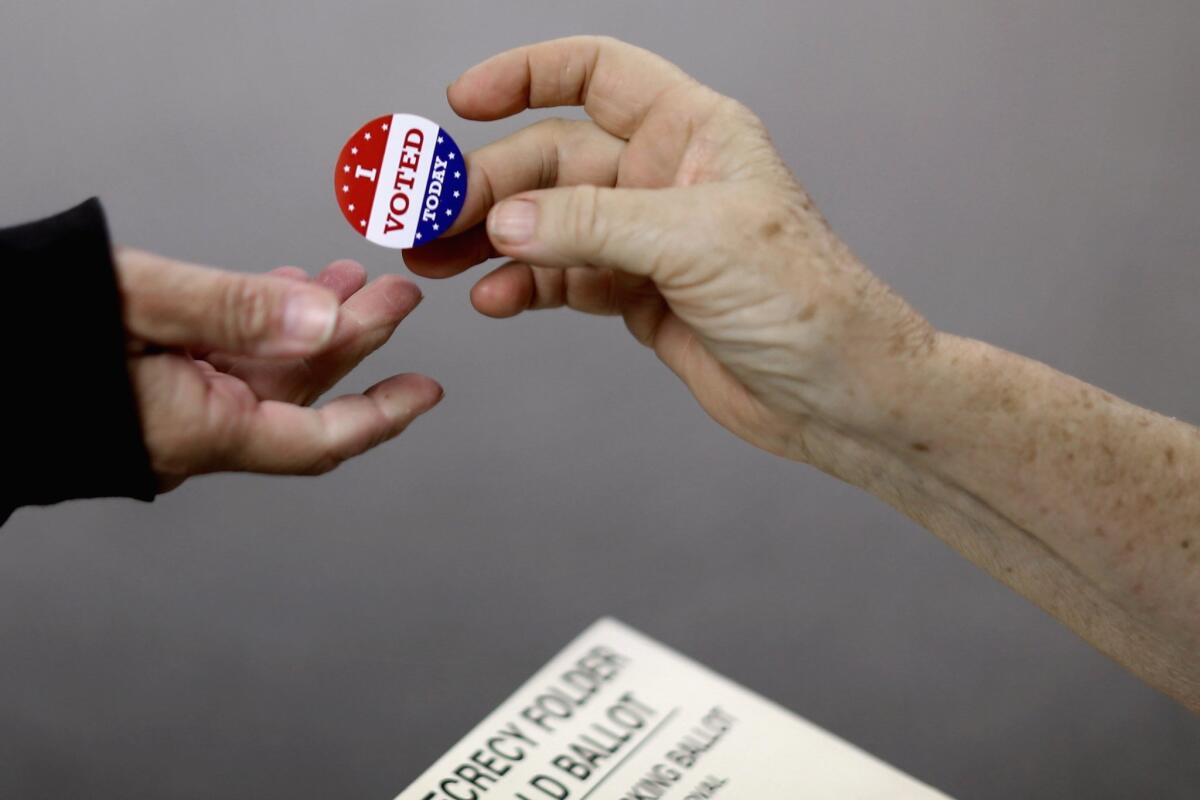Op-Ed: A chance to clarify ‘one person, one vote’

What exactly does one-person, one-vote mean?
- Share via
The U.S. Supreme Court on Tuesday agreed to hear a case that could re-do how political districts are drawn. Currently, districts in Texas are supposed to be roughly equal in total population, but a group there wants only citizens who can vote to be considered. The following piece on the case by Edward Blum was first published by The Times on May 12.
The U.S. Supreme Court on Thursday will consider hearing Sue Evenwel, et al vs. Abbott, a constitutional challenge to how Texas created its state Senate districts. Evenwel merits the court’s attention because it could reestablish electoral fairness in dozens of voting districts — not just in Texas but throughout the country.
In each of the 31 senate districts in Texas there are about 811,000 people, but there are wild disparities in the number of people per district who actually have the legal right to cast a ballot.
For example, in Sue Evenwel’s mostly rural district, about 584,000 citizens are eligible to vote. In a neighboring urban district, only 372,000 citizens are eligible. As a result, voters in the urban district have more sway than in the rural district; their individual electoral preferences carry more weight.
This imbalance violates a bedrock constitutional principle: the one-person, one-vote tenet articulated by the Supreme Court in a series of cases, the first of which was Reynolds vs. Sims. In that 1964 decision, the justices put an end to Alabama’s practice of allowing each county to have one senator in the Legislature. The old system had resulted in the voters of sparsely populated rural counties having disproportionately more senate representation than heavily populated urban counties.
Today, the disparity in voter equality mostly stems from a large and growing number of noncitizens living in Texas and elsewhere in the United States.
Let’s not confuse the issue of voter equality with the ongoing immigration debate. And forget for a moment the concern some have that noncitizens are voting fraudulently. Whatever the number of elections affected by noncitizen voting fraud, it is dwarfed by the number of contests that noncitizens have shaped legally because of the proportion of ineligible persons in certain districts. This problem crops up in a handful of states beyond Texas, including California, Arizona and New York.
The Supreme Court has long held that population deviations between voting districts cannot be greater than 10%. The one exception to that rule is congressional districts, which must not have any population deviation. Yet, the court has never defined a critical variable in this equation: namely, what is the relevant “population”?
In other words, who is the “person” in one-person, one-vote?
It is a question that continues to bedevil the lower courts. The U.S. 5th Circuit Court of Appeals has held that which population to count is “a choice left to the political process.”
The U.S. 9th Circuit, in contrast, has held that using citizen voting-age population instead of total voting-age population in these contexts would violate the Constitution because it would diminish the representational equality of the noncitizens.
Evenwel presents the justices with an opportunity to provide resolution. If one-person, one-vote — one of our most enduring egalitarian principles — has any meaning, the citizen population gaps between these new districts must not be this glaringly wide. A basic legal principle recognizes that voting is a zero-sum game; if the weight of one vote increases, the weight of another vote necessarily decreases.
Fifteen years ago, the Supreme Court declined to take up a case from Houston that would have addressed this issue. Justice Clarence Thomas, however, thought the court should hear it, writing that the court has never determined the relevant population that jurisdictions must equally distribute among their districts. And he noted that there is a split in the appellate circuits over who gets counted, and “as long as we sustain the one-person, one-vote principle, we have an obligation to explain to states and localities what it actually means.” He was right.
The issue of voter equality is not going away, and it is long overdue for the court to act on this growing problem. Sue Evenwel and hundreds of thousands of other voters deserve nothing less.
Edward Blum, a visiting fellow at the American Enterprise Institute, is president of the Project on Fair Representation.
Follow the Opinion section on Twitter @latimesopinion and Facebook
More to Read
A cure for the common opinion
Get thought-provoking perspectives with our weekly newsletter.
You may occasionally receive promotional content from the Los Angeles Times.










